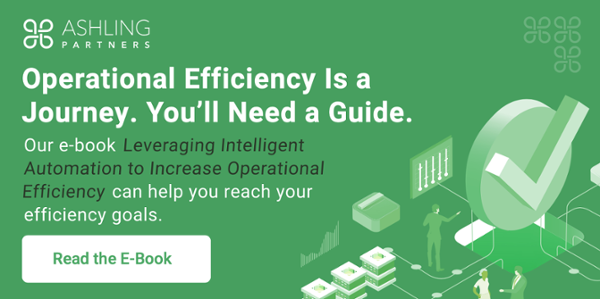The path toward digital transformation for any enterprise involves many carefully placed stones. How you construct your path has a lot to do with your people, processes, and technology. Automation is a significant piece of a good foundation; however, implementing it in a few processes isn’t enough to accelerate your digital transformation initiatives. For a truly successful transformation, your organization will need to achieve scalable automation.
Moving from pockets of automation throughout your business to true end-to-end automation is the objective of scaling. More investment in digital transformation—which includes automation—is a priority for many, with spending forecasted to reach $3.4 trillion by 2026. Additionally, 80 percent of executives believe automation can apply to any business decision. Reaching your company’s digital transformation goals requires a focus on scalable automation.
How can you scale reliably to pave that path to digital transformation? Let’s dig into this topic to define scalable automation, discover how to achieve it, and explore its connection to digital transformation.
What Is Scalable Automation?
Scalable automation describes an enterprise’s ability to go from dabbling in automation to using it for end-to-end processes across the business. It involves Robotic Process Automation (RPA) and Intelligent Process Automation (IPA).
Scaling typically starts with RPA, which is the basic level of automation and the core of many programs. Taking things to the next level involves IPA, which combines RPA with Artificial Intelligence (AI) and Machine Learning (ML).
RPA and IPA are vital in facilitating digital transformation. These digital robots and their capabilities to learn and support decision-making are highly valuable to business leaders. Yet it’s not as simple as plugging in some automation and reusing it throughout the enterprise.
Milestones for scaling an automation program include the following:
- Successful deployment of RPA and IPA
- Agility in the framework of managing the automation
- Alignment with corporate objectives so that scaled automation weaves into the fabric of the greater organizational strategy
- Realized value from the automation, such as reduced costs, deeper data insights, increased productivity, or enhanced customer experiences
With these parameters, you can move to attain scale.
How Do Organizations Achieve Scale?
Scaling can look different for every enterprise. Many factors inform your journey, including your goals, industry, pain points, and more.
There are many steps along the way to achieving scale. Several automation strategies can assist your company’s journey toward scalability, including:
- Process Mining, which uses data from enterprise systems to visualize how transactions flow through a process.
- Building your Center of Excellence (CoE), which provides direction and vision for an automation program.
- Identifying your automaton and digital transformation goals.
- Developing a readiness plan to drive business change effectively.
Digital transformation creates positive change by defining or improving business processes. Its principles consist of technology, processes, and methodologies to drive that change. The result is efficiency, value, and innovation. There are many roads to this result, but they all lead back to scalable automation.
What Are the Right Components That Make Automation Scalable?
Scalable automation involves a strategic road map. Your organization has to develop a detailed plan to accomplish scale, and such an exercise will encounter challenges.
In defining the plan, you must look for opportunities within processes and their relationship to digital transformation. With this lens, you can evaluate how to achieve scale by considering the business results and the potential to adopt them across the organization.
Scaling automation has unique attributes versus other technologies because it’s not tied to only one project, location, line of business, or process. Scaling involves a “building” process for RPA and IPA.
You’ll start with RPA. The workflows most suited for RPA are repetitive and rules-based. They also tend to run throughout an organization and touch many departments and users. You typically need to scale RPA before IPA; they are interconnected, but RPA is your foundation.
The most critical elements for realizing success in scaling are:
- Having confidence that RPA and IPA can handle spikes in transactions and be flexible enough to expand the scope
- Establishing enterprise-wide approaches to implementing and managing automation
- Aligning automation with digital transformation and business objectives
- Transitioning from siloed automations to interdisciplinary ones
- Making data-driven decisions about automation iterations and improvements
- Continuing to leverage your CoE because it will define the framework, govern initiatives, and help you select automation technology
When you reach scale, it’s time to use it to accelerate digital transformation. We’ll look at some specific use cases next.
Key Use Cases for Scalable Automation and Digital Transformation
For more context on scalability and digital transformation, it’s useful to look at some use cases.
Healthcare: Optimizing Hospital Operations
Hospital operations need to modernize to reduce costs and improve decision-making. These organizations are often massive, and hospital administrators want to leverage automation to hit digital transformation goals relating to staffing, scheduling, supply chain management, and patient flow. They often have data in multiple systems and interoperability can be a problem. By applying RPA and IPA at scale, administrators can access real-time, holistic data across the facility to inform all these processes.
Digitally transforming the supply chain can reduce process costs by 50 percent and increase revenue by 20 percent. Those are objectives that hospitals want to hit, and automation supports this journey.
E-Commerce Order Fulfillment
Order fulfillment is often complex and involves many steps, and being efficient and on time is critical. Such a complicated workflow includes several platforms, including third-party logistics, Enterprise Resource Planning (ERPs), and operation management software.
Scaled automation can streamline the process, enabling access to the right data, identifying gaps and bottlenecks, and forecasting demand more accurately. As a result of this integrated approach, you’ll hit your digital transformation objectives.
Manufacturing: Reaching Industry 4.0
Manufacturers are digitally transforming using Industry 4.0 initiatives, including Internet of Things (IoT) devices, blockchain, AI and ML, human-machine interaction, and additive manufacturing. These elements make manufacturers more competitive, accurate, and efficient.
Scaled automation plays a critical role. Applying RPA and IPA to end-to-end workflows helps manufacturers reach Industry 4.0. Some examples include aggregating and analyzing IoT data for predictive maintenance of machinery, supporting quality control by finding defects, and optimizing operations with intelligent workflows.
Automation at Scale Paves Your Way to Digital Transformation
When scaled, RPA and IPA provide quick wins and set the stage for long-term objectives. Automation disrupts dated business models, which allows your organization to transform digitally, boosting efficiency and reducing waste. IPA unlocks a new level of digital transformation with the ability to capture and consolidate data from many systems, from chatbots to IoT devices. The data can be structured, unstructured, or semi-structured. With Machine Learning, you can derive meanings from patterns, supporting better decision-making. Being data-rich is essential to digital transformation.
IPA has many other outcomes that intertwine with digital transformation:
- Bring products or services to market faster.
- Optimize your return from your automation investments.
- Focus on customer-centric improvements in your products.
Scaled automation also empowers every employee, supporting their workflows so they can create more value for the organization.
Scaling Is a Journey; Ashling Partners Helps You Navigate
The challenges of scaling are many. However, it’s possible to do so in an efficient, measured way that gets you closer to digital transformation objectives. On this journey, you can rely on the experts at Ashling Partners to help you navigate.
Learn about automation, scalability, and operational efficiency by reading Leveraging Intelligent Automation to Increase Operational Efficiency.



